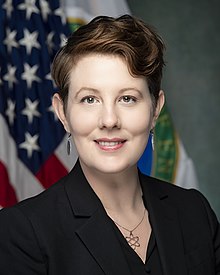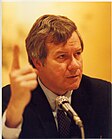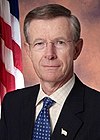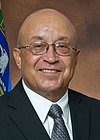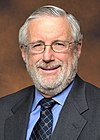
Oak Ridge National Laboratory (ORNL) is a federally funded research and development center in Oak Ridge, Tennessee, United States. Founded in 1943, the laboratory is now sponsored by the United States Department of Energy and administered by UT–Battelle, LLC.

The United States Department of Energy (DOE) is an executive department of the U.S. federal government that oversees U.S. national energy policy and energy production, the research and development of nuclear power, the military's nuclear weapons program, nuclear reactor production for the United States Navy, energy-related research, and energy conservation.
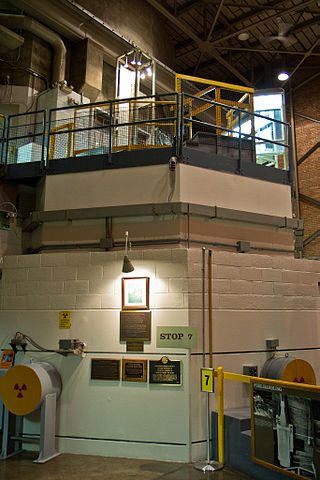
Experimental Breeder Reactor I (EBR-I) is a decommissioned research reactor and U.S. National Historic Landmark located in the desert about 18 miles (29 km) southeast of Arco, Idaho. It was the world's first breeder reactor. At 1:50 p.m. on December 20, 1951, it became one of the world's first electricity-generating nuclear power plants when it produced sufficient electricity to illuminate four 200-watt light bulbs. EBR-I subsequently generated sufficient electricity to power its building, and continued to be used for experimental purposes until it was decommissioned in 1964. The museum is open for visitors from late May until early September.

The United States Department of Energy National Laboratories and Technology Centers is a system of laboratories overseen by the United States Department of Energy (DOE) for scientific and technological research. The primary mission of the DOE national laboratories is to conduct research and development (R&D) addressing national priorities: energy and climate, the environment, national security, and health. Sixteen of the seventeen DOE national laboratories are federally funded research and development centers administered, managed, operated and staffed by private-sector organizations under management and operating (M&O) contracts with the DOE. The National Laboratory system was established in the wake of World War II, during which the United States had quickly set-up and pursued advanced scientific research in the sprawling Manhattan Project.

Idaho National Laboratory (INL) is one of the national laboratories of the United States Department of Energy and is managed by the Battelle Energy Alliance. Historically, the lab has been involved with nuclear research, although the laboratory does other research as well. Much of current knowledge about how nuclear reactors behave and misbehave was discovered at what is now Idaho National Laboratory. John Grossenbacher, former INL director, said, "The history of nuclear energy for peaceful application has principally been written in Idaho".

A molten salt reactor (MSR) is a class of nuclear fission reactor in which the primary nuclear reactor coolant and/or the fuel is a mixture of molten salt with a fissionable material.

The N-Reactor was a water/graphite-moderated nuclear reactor constructed during the Cold War and operated by the U.S. government at the Hanford Site in Washington; it began production in 1963.

A Next Generation Nuclear Plant (NGNP) is a specific proposed generation IV very-high-temperature reactor (VHTR) that could be coupled to a neighboring hydrogen production facility. It could also produce electricity and supply process heat. Up to 30% of this heat could be used to produce hydrogen via high-temperature electrolysis significantly reducing the cost of the process. The envisioned reactor design is helium-cooled, using graphite-moderated thermal neutrons, and TRISO fueled.
The National Nuclear Security Administration (NNSA) is a United States federal agency responsible for safeguarding national security through the military application of nuclear science. NNSA maintains and enhances the safety, security, and effectiveness of the U.S. nuclear weapons stockpile; works to reduce the global danger from weapons of mass destruction; provides the United States Navy with safe and effective nuclear propulsion; and responds to nuclear and radiological emergencies in the United States and abroad.
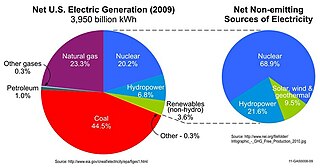
The Light Water Reactor Sustainability Program is a U.S. government research and development program. It is directed by the United States Department of Energy and is aimed at performing research and compiling data necessary to qualify for licenses to extend the life of America's current 104 electricity generating nuclear power plants beyond 60 years of life. Practically all of the commercial electric-generating nuclear power plants currently in the United States are light water reactor (LWR) plants, meaning they use ordinary (light) water as a moderator and coolant simultaneously.
Alvin William Trivelpiece was an American physicist whose varied career included positions as director of the Office of Energy Research of the U.S. Department of Energy (DOE), executive officer of the American Association for the Advancement of Science (AAAS), and director of Oak Ridge National Laboratory (ORNL). He was also a professor of physics and a corporate executive. Trivelpiece's research focused on plasma physics, controlled thermonuclear research, and particle accelerators. He received several patents for accelerators and microwave devices. He died in Rancho Santa Margarita, California in August 2022 at the age of 91.

RELAP5-3D is a simulation tool that allows users to model the coupled behavior of the reactor coolant system and the core for various operational transients and postulated accidents that might occur in a nuclear reactor. RELAP5-3D can be used for reactor safety analysis, reactor design, simulator training of operators, and as an educational tool by universities. RELAP5-3D was developed at Idaho National Laboratory to address the pressing need for reactor safety analysis and continues to be developed through the United States Department of Energy and the International RELAP5 Users Group (IRUG) with over $3 million invested annually. The code is distributed through INL's Technology Deployment Office and is licensed to numerous universities, governments, and corporations worldwide.
Consortium for the Advanced Simulation of Light Water Reactors (CASL) is an Energy Innovation Hub sponsored by United States Department of Energy (DOE) and based at Oak Ridge National Laboratory (ORNL). CASL combines fundamental research and technology development through an integrated partnership of government, academia, and industry that extends across the nuclear energy enterprise. The goal of CASL is to develop advanced computational models of light water reactors (LWRs) that can be used by utilities, fuel vendors, universities, and national laboratories to help improve the performance of existing and future nuclear reactors. CASL was created in May 2010, and was the first energy innovation hub to be awarded.

The Transient Reactor Test Facility (TREAT) is an air-cooled, graphite moderated, thermal spectrum test nuclear reactor designed to test reactor fuels and structural materials. Constructed in 1958, and operated from 1959 until 1994, TREAT was built to conduct transient reactor tests where the test material is subjected to neutron pulses that can simulate conditions ranging from mild transients to reactor accidents. TREAT was designed by Argonne National Laboratory, and is located at the Idaho National Laboratory. Since original construction, the facility had additions or systems upgrades in 1963, 1972, 1982, and 1988. The 1988 addition was extensive, and included upgrades of most of the instrumentation and control systems.

Robert Louis (Bob) Ferguson was a nuclear-trained physicist and a 60-year veteran in the field of nuclear energy. He was best known for being appointed the first Deputy Assistant Secretary for Nuclear Energy Programs for the U.S. Department of Energy (DOE) by the first Energy Secretary, James Schlesinger, serving from 1978 to 1980 during President Jimmy Carter's administration.

Rita Baranwal served as the former Assistant Secretary of Energy for Nuclear Energy, the head of the Office of Nuclear Energy within the United States Department of Energy. She was confirmed to that position by the Senate on June 20, 2019, sworn in on July 11, and served until January 2021. She previously served as the Director of the Gateway for Accelerated Innovation in Nuclear (GAIN) initiative at Idaho National Laboratory starting in that role in August 2016. She previously served as the Chief Technology Officer and Senior Vice President of Digital and Innovation for Westinghouse Electric Company; currently serving as the Senior Vice President of AP300 SMR.
The Aurora powerhouse is an advanced fission plant concept design that received a site use permit for testing in 2020 from the United States Department of Energy (DOE). The site use permit, issued in December 2019 is not a Nuclear Regulatory Commission permit. It is the "first and only permit ever issued in the U.S. to a nuclear plant using something other than a light water ("water-cooled") reactor". It will use "recycled" high-assay, low-enriched uranium (HALEU) fuel originally fabricated for the Experimental Breeder Reactor II (EBR-II), and if fully operational, would become "the first fuel-recycling commercial reactor in the United States". The DOE's Idaho National Laboratory (INL) said it would provide 10 tons of HALEU for the test reactor which corresponds to most of the available supply. Reprocessing would occur at INL's Materials and Fuels Complex (MFC) and possibly also the Idaho Nuclear Technology and Engineering Center (INTEC), neither of which are operational facilities as of early 2020.
Advanced Reactivity Measurement Facility I (ARMF-I) was a research reactor which was located at the Argonne National Laboratory, a United States Department of Energy national laboratory, facility located in the high desert of southeastern Idaho between Idaho Falls, Idaho and Arco, Idaho. ARMF-I was nearly identical to ARMF-II.
Advanced Reactivity Measurement Facility II (ARMF-II) was a research reactor which was located at the Argonne National Laboratory, a United States Department of Energy national laboratory, facility located in the high desert of southeastern Idaho between Idaho Falls, Idaho and Arco, Idaho. ARMF-II was nearly identical to ARMF-I.

Titans of Nuclear is an interview podcast developed by the Energy Impact Center. Each episode features interviews led by Bret Kugelmass. Other hosts include Jadwiga Najder, Olubunmi Olajide, and Naomi Senehi. Guests generally include nuclear energy experts who come from various political, scientific, and business backgrounds. The one-on-one discussions typically revolve around nuclear energy and related topics including political policy, climate change, and nuclear medicine.
